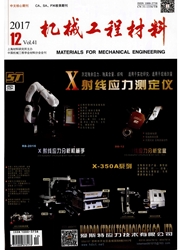

 中文摘要:
中文摘要:
在不同的电解液体系中,利用阳极氧化法在TC4钛合金基体上制备了不同形貌的TiO2薄膜,分析了电解液体系及电压对薄膜形貌的影响;测试了薄膜的显微硬度、弹性模量和摩擦磨损性能。结果表明:TiO2薄膜的形貌与电压、电解液密切相关,电压过小或过大时薄膜形貌呈非纳米管结构,在HF溶液及含F-的无机电解液中,电压在10~20V时,薄膜形貌呈有序的纳米管状;在含F-的有机电解液中,当电压为40V时,薄膜呈纳米弹簧结构;非纳米管结构薄膜的显微硬度大,弹性模量高,耐磨性不佳;纳米管的管径与壁厚的比值越小,薄膜的力学性能和耐磨性越好;纳米弹簧状薄膜的显微硬度和弹性模量皆较小,摩擦因数高,磨损量大。
 英文摘要:
英文摘要:
TiO2 films with different morphology were prepared on TCA Titanium alloy surface by anodic oxidation method under the conditions of different electrolyte solutions and reaction voltages. The effects of electrolyte solutions and reaction voltages on the morphology of the film were analyzed, and the microhardness, elasticity modulus and friction and wear properties of the films were tested. The results indicate that the morphology of the film was closely related to the electrolyte solution and the reaction voltage, when the reaction voltage was too low or too high, the film without nanotube structure would be formed. In the HF aqueous solution and inorganic electrolyte containing F-, when the reaction voltage was 10-20 V, the morphology of the films exhibited nanotube structure. In the organic electrolye containing F-, when the reaction voltage was 40 V, the morphology of the film looked like nano-spring structure. The film without nanotube structure had high microhardness, high elastic modulus and low friction resistance. The smaller the ratio of nanotube diameter to wall thickness, the better the mechanical and wear resistance of the film. The films with nano-spring srtucture owned smaller micro-hardness and elasticity modulus, hgher friction coefficient and wear loss.
 同期刊论文项目
同期刊论文项目
 同项目期刊论文
同项目期刊论文
 期刊信息
期刊信息
